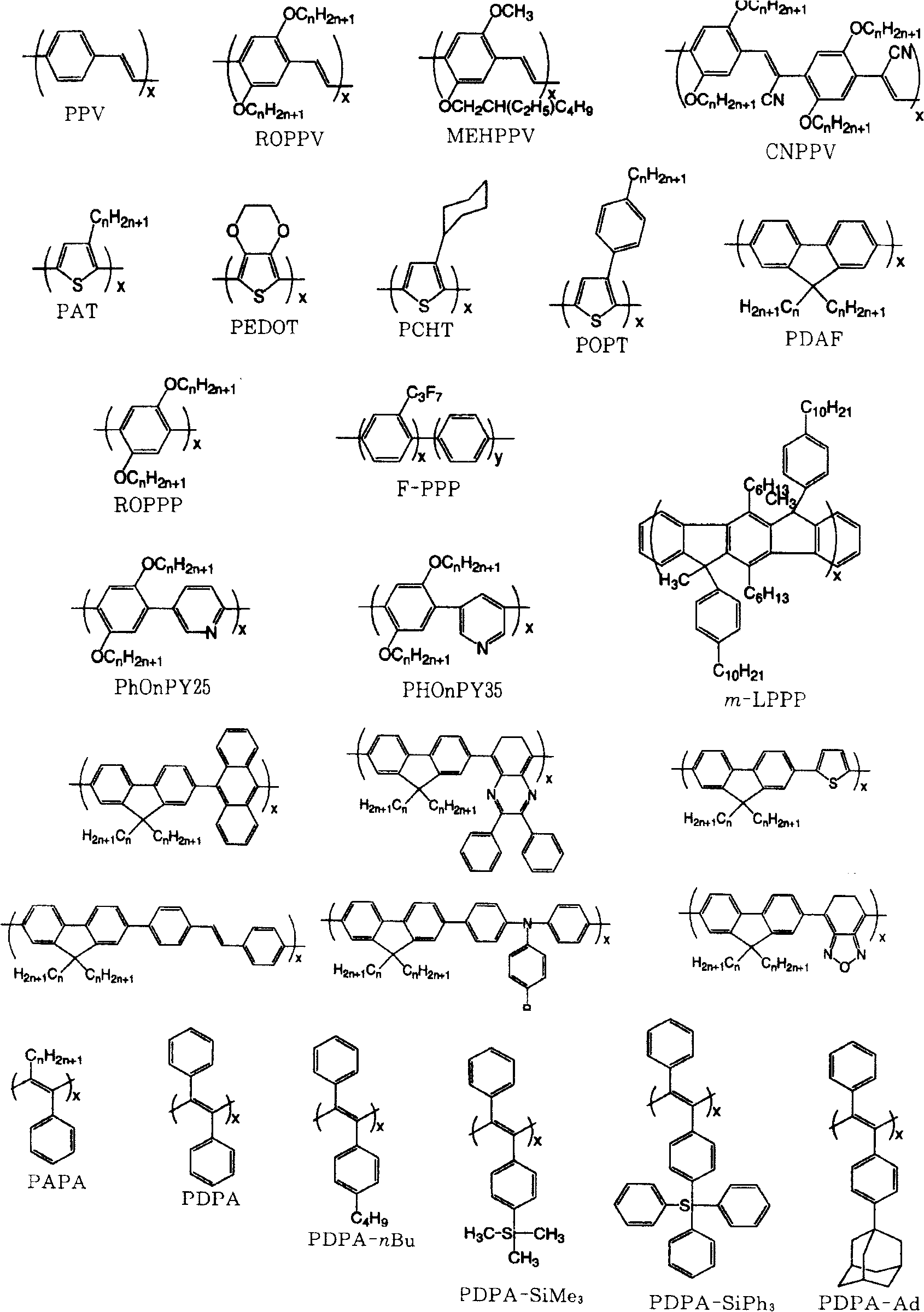Conductive composite body, electric charge transmission material and organic luminous diode
A conductive polymer, conductive technology, applied in non-metallic conductors, electric solid devices, semiconductor devices, etc., can solve problems such as low performance
- Summary
- Abstract
- Description
- Claims
- Application Information
AI Technical Summary
Problems solved by technology
Method used
Image
Examples
Embodiment 1
[0097] 2g of 3,4-ethylenedioxythiophene, 170g of 3wt% polystyrenesulfonic acid aqueous solution, 4g of sodium persulfate, 1g of iron sulfate and 850ml of pure water were mixed and stirred for 3 hours. After adding 10 g of hydroxyethyl acrylate (HEA) to this reaction solution, it was heated and stirred for 3 hours.
[0098] After letting cool, handle with ion-exchange resin and ultrafiltration, obtain the aqueous solution (hereinafter referred to as poly(3,4-ethylenedioxy) thiophene and polyhydroxyethyl acrylate of deep blue 1.6wt% polystyrenesulfonic acid-poly(3,4-ethylenedioxy) thiophene and polyhydroxyethyl acrylate : Aqueous solution 1).
[0099] After mixing 1 g of aqueous solution 1 and 5 g of ethanol, mixed ethanol aqueous solution 1 was obtained. After coating the ethanol aqueous solution 1 on the polyester film and drying it in an oven at 120°C for 60 minutes, the conductive thin coating film was obtained. Table 1 shows the results of evaluating the resistivity of th...
Embodiment 2
[0101] 2g of 3,4-ethylenedioxythiophene, 170g of 3wt% polystyrene sulfonic acid aqueous solution, 4g of sodium persulfate, 1g of ferric sulfate and 850ml of pure water were mixed and stirred for 3 hours to obtain a reaction Liquid 1.
[0102] After mixing 10 g of hydroxyphthalamide acrylate, 0.1 g of sodium persulfate, and 200 ml of pure water, they were heated and stirred for 15 minutes to obtain a reaction solution 2.
[0103] The reaction solution 1 was added to the reaction solution 2, and heated and stirred for 1 hour.
[0104] After letting cool, handle with ion-exchange resin and ultrafiltration method, obtain the aqueous solution (hereinafter referred to as the polystyrene sulfonic acid of 1.6wt% of dark blue-poly(3,4-ethylenedioxy) thiophene and polyacrylic acid hydroxamide : aqueous solution 2).
[0105] In the same manner as in Example 1, a conductive thin coating film was produced, and the resistivity of the conductive thin coating film was evaluated. The results...
Embodiment 3
[0107] With the same method as Example 1, except changing 10g hydroxyethyl acrylate (HEA) into the acrylic acid (AA) of 15g, all obtain 1.6wt% polystyrenesulfonic acid-poly(3, 4-ethylenedioxy)thiophene-polyacrylic acid (AA) (hereinafter referred to as: aqueous solution 3).
[0108] In the same manner as in Example 1, a conductive thin coating film was produced, and the resistivity of the conductive thin coating film was evaluated. The results are shown in Table 1.
PUM
| Property | Measurement | Unit |
|---|---|---|
| particle diameter | aaaaa | aaaaa |
| thickness | aaaaa | aaaaa |
| thickness | aaaaa | aaaaa |
Abstract
Description
Claims
Application Information
 Login to View More
Login to View More - R&D
- Intellectual Property
- Life Sciences
- Materials
- Tech Scout
- Unparalleled Data Quality
- Higher Quality Content
- 60% Fewer Hallucinations
Browse by: Latest US Patents, China's latest patents, Technical Efficacy Thesaurus, Application Domain, Technology Topic, Popular Technical Reports.
© 2025 PatSnap. All rights reserved.Legal|Privacy policy|Modern Slavery Act Transparency Statement|Sitemap|About US| Contact US: help@patsnap.com

